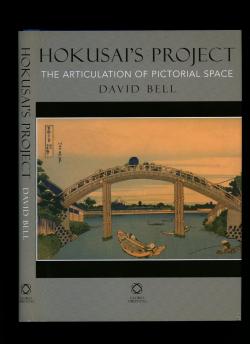Hokusai's Project: The Articulation of Pictorial Space

By David Bell
Global Oriental, 2007
ISBN-13: 978-1-905246-15-1
Review by Sir Hugh Cortazzi
David Bell of the University of Otago, New Zealand, is a specialist in ukiyo-e and has written a number of books for specialists in Japanese art history including Ukiyo-e Explained published by Global Oriental in 2004. His new book is a useful addition to the many volumes written about Hokusai, his life and his art. It will be primarily of interest to students of Japanese colour prints.
David Bell explains that his study concentrates on how Hokusai employed "pictorial conventions in the organization of pictorial space" or in other words how he set about making pictures. Bell is concerned not with who Hokusai was or what he did but rather with "why his works appear the way they do."
In his "Prologue: Hokusai's Project" Bell draws attention to Hokusai's mastery of drawing and his determination that "the drawn image represented the real object in a convincing manner." Chapter 2 is entitled "How Hokusai Learned his Trade" and shows the extent to which he absorbed the styles of the various schools of Japanese painting and western perspective. Hokusai was, however, to quote Laurence Binyon, a "fiercely independent but eclectic figure, constantly changing course, in his artistic career as in his personal life, unable to resign himself to any settled mode of existence, and so completely industrious as to be quite insensible to the world about him." Bell notes that Hokusai increasingly diverged from ukiyo-e's emphasis on the hedonistic world of the theatre and the Yoshiwara, and "focussed on the humble, the everyday, the unremarkable."
Chapter 3 "Hokusai, Fuji and the Articulation of Pictorial Space" is the longest in the book, although Bell points out that "Fuji pictures occupy a relatively small part of Hokusai's project." Bell draws attention to the imaginative way in which Hokusai depicted Fuji and how "by constructing a deep pictorial space" he "could represent the landscape itself in a naturalistic manner, and could arrange the incidental interest of figure groups, architectural complexes or well-known landmarks within convincing pictorial contexts." After discussing Hokusai's famous thirty-six views of Mount Fuji (in fact the there were forty-six views in the series) Bell turns to the less well-known "hundred views" which were "constructed within closely delimited, sometimes almost minimalist, means." One of the most striking is that of "Fuji in a Downpour" (page 135, plate 52).
The fourth and last chapter is entitled "Hokusai: Flowers, the Poets and Aesthetic detachment." Here Bell draws attention to Hokusai's delicate juxtaposition of a bird or an insect with the fugitive beauty of flower petals."
The book requires a concentrated effort on the reader's part as Bell's writing is dense and his sentences often long and convoluted. The colour of the reproductions is uneven.

